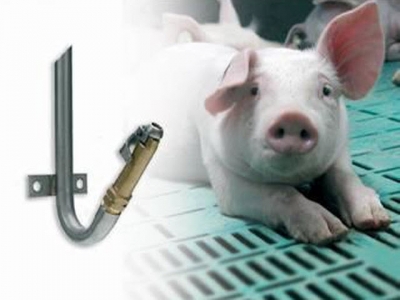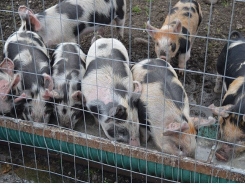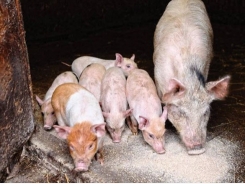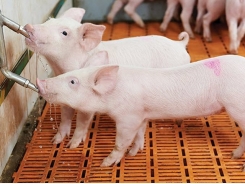Comparing pig drinking systems

Pigs need a safe, clean and readily available water source in order to survive. However, the effect that drinkers have on productivity and efficiency is often overlooked.
Water is an essential nutrient for all living things; as obvious as this may be, its importance is often forgotten. The quality of the water that pigs drink is vital -- contamination spreads disease, and impurities can affect consumption. However, even if quality is maintained, pigs must be given the opportunity to consume the amount of water they need for optimum performance. Number of drinkers per animal, their placement and water flow rates all need careful consideration.
There are three main types of drinkers used commercially: nipples, bowls and troughs, with numerous variations available. The suitability of each type for different production systems, along with considerations on age of pig, will be discussed in this article. Key selling points for drinker systems are often based on reducing water wastage. Wastage results in greater slurry volumes, higher water charges and potentially increased electricity usage for pumping -- all of which impact a producer’s bottom line.
Drinker essentials
All pigs need continuous access to an adequate supply of fresh, clean water; otherwise, health and performance will be affected. Any contamination, or if the water has a high mineral content, will discourage drinking. If not enough water is consumed, feed intake is reduced, negatively affecting daily gain and feed conversion. The water supply must also be in easy reach of the pigs. Drinkers should be correctly positioned and enough installed for the number of pigs housed. Too few and the less dominant animals may not get the chance to drink sufficiently.

Courtesy of Weda | Cup drinker
Manufacturers and assurance schemes often recommend one nipple or mini-bowl/cup drinker per 10 pigs. This can be reduced to one per 15 or 30 pigs if ad-lib or wet-feeding practices are employed. They should also be sufficiently spaced so that they can all be used at the same time. Individually housed animals will of course need one drinker per animal, but some models offer two or more nipples from the same drinker tube reducing installation costs by supplying more than one pen. If troughs are used, the space available per animal, depending on their weight, should be calculated.
Guidelines are in place from two weeks of age, as sow’s milk should give sufficient hydration beforehand. However, drinker introduction is important and it is worth providing a piglet nipple drinker or one with a bowl/cup. Similarly, when newly-weaned piglets are moved to pens with unfamiliar drinkers it is advisable to provide an alternative water source for the first few days. Drinkers mustn’t become a hazard in the house; nipple drinkers in-particular can cause injuries, so guards may need to be installed.
Water requirements and flow rates
As pigs won’t spend a long time drinking, flow rates needs to be set to supply water requirements in a reasonable amount of time. A low flow rate may reduce water intake, as they may get bored or be pushed away from the drinker before they have had their fill. Sows have a high demand for water, particularly during lactation, so a high-pressure system may be needed. However, flow rates must not be so high as to result in water wastage.
Nipple drinkers

Bowl and nipple drinkers
Nipple drinkers can be used by all pigs and should be adjusted to a height five centimeters above the smallest pig in the pen. This means that the pig’s head is tipped upwards, at 45 degrees, allowing water to flow straight into their mouth. If the same housing is used throughout the finishing period, there are three main ways of ensuring the drinkers are at a suitable height. Drinkers can be attached to adjustable brackets so they can be raised as the pigs grow. Some models offers two nipples at different heights but they should still be counted as one drinking space. Alternatively, the drinkers can be set at a mid-point where the youngest pigs can still reach them but the older ones don’t spill too much.
A common adaptation of the nipple drinker is the addition of a bite valve. The pigs have to bite down on a ball, which pushes a lever that releases the water flow. This system means that there is less water spilled by the pigs, reducing water usage and wastage by a third in growing pigs. They may cost nearly twice that of a standard nipple drinker but save money in terms of water wastage and increased durability. Another type has a mechanism, which interrupts the flow of water while the pig swallows and can reduce water wastage by at least 50 percent in growers, finishers and sows.
Bowls

Courtesy of Weda | Bowl drinker
Bowls or cups fit around a nipple drinker and catch any spilled water; this can then be drunk, further reducing wastage. Different designs and sizes are available for piglets, weaners, finishers and sows. For sucking pigs the ability to see the water in the bowl encourages drinking. When sited appropriately both sows and their piglets can use the same bowls. Larger bowl drinkers may allow more than one pig to drink at the same time and can be counted as two drinker spaces. The height of drinking bowls needs to be appropriate for the size of the pigs. Too high and drinking will be difficult or too low and the bowl may become contaminated. Some bowls have a closed design to prevent contamination by feces or bedding. Rounded edges also help to prevent injuries and naturally protect the nipple itself.
Troughs
Troughs are the most common choice for outdoor systems and can have a place in piglet and weaner housing, where visible water helps to encourage drinking. They can become contaminated with feed, bedding material, urine or feces, so they need to be checked and cleaned regularly. Troughs can be manually filled or flooding systems installed to automatically replenish the water as the pigs drink. Troughs with integrated bite drinkers are an option, which are easier to keep clean. In outdoor systems, the provision of water in freezing conditions is an issue and a back-up reservoir of water is useful.
Water wastage
Water is a valuable commodity; reducing wastage has economic and environmental benefits. The more water wasted, the greater the volume of slurry produced, which needs to be stored and spread. Properly adjusting the height and flow rates of nipple drinkers can reduce water wastage by up to 20 percent for grower/finisher pigs. Installing water meters allows producers to monitor their usage. They are a powerful management tool, enabling changes such as flow rate, drinker height or type to be evaluated.
Commercial considerations
Producers need a drinking system that is durable, minimizes waste and suits their housing system. In terms of pig performance, evaluations have not picked up consistent differences between drinker designs. However, drinkers must be positioned correctly, have a suitable flow rate and enough provided per pig. Drinkers should be kept clean and maintained to ensure a reliable supply. The most important attribute of any drinking system is to provide sufficient fresh, clean water.

Courtesy of Big Dutchman
Learn more about how pigs' water intake plays a key role in their health and performance
Related news
Tools

Phối trộn thức ăn chăn nuôi

Pha dung dịch thủy canh

Định mức cho tôm ăn

Phối trộn phân bón NPK

Xác định tỷ lệ tôm sống

Chuyển đổi đơn vị phân bón

Xác định công suất sục khí

Chuyển đổi đơn vị tôm

Tính diện tích nhà kính

Tính thể tích ao




 What you should know about gastric ulcers in…
What you should know about gastric ulcers in…  Piglets need water as much as they need…
Piglets need water as much as they need…